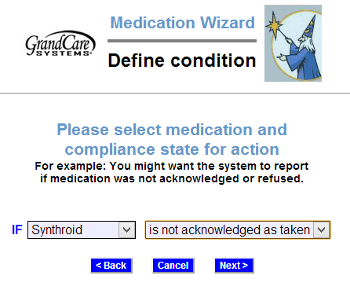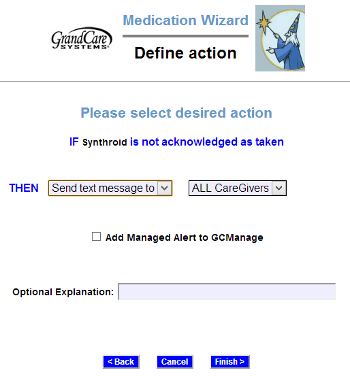Difference between revisions of "Medication Rules"
m (Adjusted white space) |
m (Fixed typos) |
||
| Line 19: | Line 19: | ||
Examples of conditions might be: | Examples of conditions might be: | ||
* If any medication is refused by the Resident, email a Caregiver. | * If any medication is refused by the Resident, email a Caregiver. | ||
* If Synthroid is not acknowledged as taken, make a reminder call. | |||
Once you have defined the condition, you need to set the action. Possible actions include contacting a single caregiver, all caregivers, or a [[Call List|Call List]]. The types of contact include: | Once you have defined the condition, you need to set the action. Possible actions include contacting a single caregiver, all caregivers, or a [[Call List|Call List]]. The types of contact include: | ||
Revision as of 21:45, 25 July 2013
Setting RulesYou can set up medication rules to alert caregivers when the Resident reports that meds have been taken, or when the Resident hasn't. To add a medication rule:
|
There are two parts to each rule, a condition and an action. On the first screen, define the condition. Your rule can be triggered when:
- The Resident presses an on-screen button to acknowledge taking meds scheduled for that time
- The Resident doesn't press an on-screen button to acknowledge taking the meds (either by pressing an on-screen button refusing the meds, or by not pressing any button to acknowledge the meds scheduled for that time)
- The Resident presses an on-screen button refusing the meds scheduled for that time
Examples of conditions might be:
- If any medication is refused by the Resident, email a Caregiver.
- If Synthroid is not acknowledged as taken, make a reminder call.
Once you have defined the condition, you need to set the action. Possible actions include contacting a single caregiver, all caregivers, or a Call List. The types of contact include:
- Text message
- Phone call to home, work or cell phone
- Phone call to a Call List
Multiple rules can be triggered for any event, so that multiple types of alerts can be sent out, for example both phone calls and emails.
A checkbox next to the rule lets you set whether the rule is enabled or disabled. It might make sense to turn off a rule while your loved one is on vacation, so that alerts won't be sent out during that time. You can disable a rule by unchecking the box. When you're ready for the rule to be active again, just check the Enabled checkbox again, and then save the rule settings.

